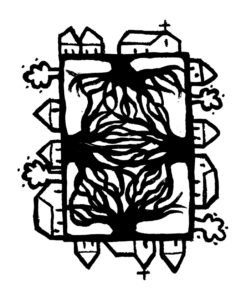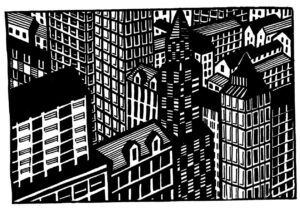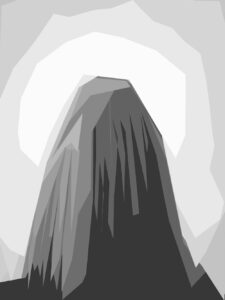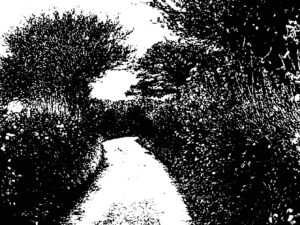In the early days of ‘earth mysteries’ research, exploratory steps were being taken towards place and the meanings that attach to it, culturally and subjectively, past and present. However, the field was rather thrown off course in the 1970s by the unproductive ‘earth energy’ fascination.
NE believes it is time to retrace those steps, and here Bob Trubshaw discusses one aspect of that bypassed avenue of research, and reviews its relevance to neo-antiquarianism today
Psychogeography isn’t what you think it is. At least not if your idea of psychogeography is influenced by Will Self’s ramblings under that moniker in The Independent. Before Self hijacked the term for his own agenda, if anyone at all knew what it meant they would either think of obscure 1950s Parisian avant-garde intellectual movements or the works of a group of London-based writers such as Iain Sinclair and Peter Ackroyd. Both of these are essentially urban, so they stand in contrast to those aspects of ‘earth mysteries’ that seemingly might also be thought of as ‘psychological geography’.
The origins of psychogeography
Merlin Coverley (2006) has provided a useful introduction to the Parisian and London manifestations of pychogeography. He traces its origins with the Lettrist International and, subsequently, Situationist International movements in 1950s Paris. The exotic terminology – such as flâneur and dérive – of Guy Debord has entered the discourse of English postmodernism untranslated, to denote aimless (or sometimes erotically-charged) wandering of urban streets – a common trope of psychogeography. However, Coverley convincingly argues that London rather than Paris should be considered as the cerebrum of psychogeography, and details how notions later adopted by French writers were first explored by 17th and 19th-century London authors, who in turn influenced some of the capital’s leading authors of the late 20th century.

So, rather than Debord, it is Daniel Defoe who Coverley regards as the parent of psychogeography. Defoe’s Journal of the Plague Year documents a rapidly changing mental topography of a 1660s city, in the same way that Louis Aragon’s Paris Peasant was to do in the 1920s. Robinson Crusoe – though not urban – was to have a continuing influence on writers who came under the psychogeography umbrella. Coverley then traces a mental map through the works of Thomas de Quincy (Confessions of an English Opium Eater, with its dream-like London anticipating Debordian dérives); Robert Louis Stevenson (The Strange Case of Dr Jekyll and Mr Hyde, which starts the endless flood of imaginary gothic underworlds sharing the metropolis’s material manifestations); Arthur Machen (whose The London Adventure is the exact contemporary of Aragon’s proto-flâneur); Iain Sinclair (whose affiliation with psychogeography starts with Lud Heat, but includes much of his subsequent output); and Peter Ackroyd (Hawksmoor and his more recent non-fiction works).
Coverley notes that these London manifestations of psychogeography have a much more antiquarian aspect than their Parisian counterparts – ‘an antiquarianism that views the present through the prism of the past’ as he so evocatively states – and that this antiquarianism is, at least in the works of Machen, Sinclair and Ackroyd, linked to an obsession with the occult. Although Coverley omits any discussion of T.S. Eliot’s ‘Unreal City’ of The Waste Land, his remarks clearly can be extended to include Eliot’s mixing of Classical legends and then-contemporary culture to get under the skin of inter-war London.
The omission of Eliot is all the more surprising considering his psychogeographic-esque musings in ‘Little Gidding’, one of the Four Quartets:
We shall not cease from exploration
And the end of all our exploring
Will be to arrive at where we started
And know the place for the first time.
But I guess Coverley had to stop somewhere, though it’s a shame that he did not find a place to mention Virginia Woolf’s essay ‘Street haunting: a London adventure’ which creates a dualism between rural and urban by imagining one of the city’s street ‘with its islands of lights, and its long groves of darkness, and one side of it perhaps some tree-sprinkled, grass-grown space where night is folding herself to sleep naturally and, as one passes the iron railing, one hears those little cracklings and stirrings of leaf and twig which seem to suppose the silence of the fields all around them, an owl hooting, and far away the rattle of a train in the valley.’
Although for most of us we experience our environment visually (see McGregor 2009 for an example of psychogeographic street walking combined with what is, quite literally, street photography), our environments are also aural, with urban environments often unremittingly so. So David Toop’s recent book, Sinister Resonance (Toop 2010) – from which I lifted the Virginia Woolf quotation – is a most welcome exposition about how sound contributes to our environment, an extended lesson about both listening and the listened. While Toop’s approach is not specifically psychogeographical, reading his book adds a whole dimension of experience for any flâneur.

The exclusion of ‘earth mysteries’
Coverley’s emphasis on selected London authors challenging established mental maps of London conforms well with his definition of psychogeography as urban and politicised. But the real weakness of this treatment is the intense circularity. By defining psychogeography as urban (specifically London and, to a lesser extent, Paris) and politicised (at least in intent if not actualisation), Coverley then uses this definition to exclude a wider orbit of essentially like-minded people ‘thinking about places’ that did not place themselves under the rubric of psychogeography. After all, Coverley quotes the earliest definition of psychogeography, by Debord in the first issue of Internationale Situationniste, which reads:
The study of specific effects of the geographical environment, consciously organised or not, on the emotions and behaviour of individuals.
Such a definition would, for example, readily encompass Common Ground, the organisation set up in 1982 by Susan Clifford and Angela King to promote ‘local distinctiveness’. The only aspect of Common Ground’s agenda that separates them from Coverley’s urban re-definition of psychogeography is that their work is mostly in non-urban communities. It might also be said that they distinguish themselves by having achieved far more of their ‘political’ objectives than urban psychogeography practitioners… But Coverley makes no mention of Common Ground, not even to justify their exclusion.
Conspicuous in Coverley’s book only by their absence are the thinkers about ‘specific effects of the geographical environment’ of the 1970-90s who came to self-identify under the designation ‘earth mysteries’. They too saw the present through the ‘prism of the past’ in a similar way – although less darkly – as Ackroyd et al. Here Coverley seems to reveal the limits of his own awareness. As he repeatedly states, one of the key sources for Sinclair’s novel Lud Heat (which in turn deeply influenced Ackroyd’s Hawksmoor) was Alfred Watkins’ antiquarianism, specifically the ‘ley’ or alignment of six London churches, including St Paul’s cathedral. Apart from the inevitable repeat of the myth started in 1970 by John Michell that Watkins was riding a horse when he had conceived of the idea of ‘leys’ (he wasn’t, he was much less romantically driving a car… – see Michell 1970: xv–xvi; Adams 1978; Trubshaw 2005: 84) Coverley summarises Watkins’ ideas accurately, and even goes on to state that they were resurrected as part of the e.m. movement. But this only makes the lack of any further discussion about e.m. even more remarkable; doubly so as the London Earth Mysteries Group is now one of only two such survivors of the heyday of the movement. As will be discussed below, the anonymously-produced newsletters of the London Psychogeographical Association (LPA) were circulated to editors of all the earth mysteries magazines of the 1990s, so the LPA knew of e.m.!
 If we drop Coverley’s psychogeography-is-urban definition and revert to Debord’s more encompassing definition – and one more in accord with Will Self’s appropriation of the term, which has been responsible for its wider awareness – then the omission of earth mysteries writers such as Janet and Colin Bord and, more especially, Michael Dames, seems wayward. The distinction between Coverley’s list and these authors is less their subject matter than their genre – Coverley favours literary novel writers to the exclusion of non-fiction authors. To what extent Sinclair, Ackroyd and their London-based associates self-identify with the term ‘psychogeography’ is not explored by Coverley, but as they were writing before the ‘resurrection’ of this term by the London Psychogeographical Association in the 1990s, then the fact that the Bords, Dames and other 1970/80s e.m. writers did not (and probably would not) self-identify with the ‘psychogeography’ moniker is not, in my opinion, any reason for not exploring the great overlap in approaches.
If we drop Coverley’s psychogeography-is-urban definition and revert to Debord’s more encompassing definition – and one more in accord with Will Self’s appropriation of the term, which has been responsible for its wider awareness – then the omission of earth mysteries writers such as Janet and Colin Bord and, more especially, Michael Dames, seems wayward. The distinction between Coverley’s list and these authors is less their subject matter than their genre – Coverley favours literary novel writers to the exclusion of non-fiction authors. To what extent Sinclair, Ackroyd and their London-based associates self-identify with the term ‘psychogeography’ is not explored by Coverley, but as they were writing before the ‘resurrection’ of this term by the London Psychogeographical Association in the 1990s, then the fact that the Bords, Dames and other 1970/80s e.m. writers did not (and probably would not) self-identify with the ‘psychogeography’ moniker is not, in my opinion, any reason for not exploring the great overlap in approaches.
Ackroyd may have created for London a gothic, occult underworld associated with Hawksmoor churches. This may have generated increased interest in the buildings by tourists. But this is little compared to the vast modern pagan interest aroused in the Avebury cycle of monuments by Michael Dames’ inspirational books (1976, 1977, 2007), even if most of the present-day pagan pilgrims are probably unaware of his key role in the inception of the modern-day myths about this megalithic complex. Unlike Ackroyd, Dames did not restrict himself to one geographical location, but went on to re-mythologise large parts of Ireland (1992) and much of Wales (2002, 2006). Dames has no overt political agenda, expresses no interest in urban environments, and has had little or no contact with London literary circles, so is well outside Coverley’s remit, but well within Debord’s scope. And Dames’ career as an art college lecturer fostered familiarity with Situationist sentiments in a way that neither Sinclair nor Ackroyd appear to share.
Just as Dames is conspicuous only by his absence in Coverley’s approach to the psychogeography ground, so too is any mention of Janet and Colin Bord’s influential Mysterious Britain and its many sequels which re-bond physical places with their traditional lore and legends. Which at least makes Coverley’s omission of more arcane aspects of earth mysteries – such as Philip Heselton’s perceptive ruminations about terrestrial zodiacs (Heselton 1991) – self-consistent. Back in 1991, Philip was the first to moot that these zodiacs existed neither in the landscape nor merely in the minds of their ‘creators’ but in a combination of both – psychogeography in all-but-name.
And, somewhere on the fringes of e.m., an 8-year pre-millennial ‘Gnostic odyssey’ came to a close in 1998 when the maverick rock musician Julian Cope had visited over 300 prehistoric sites in the British Isles. His book, The Modern Antiquarian, and subsequent web site have been one of the major popular sources for inspiration (and more-or-less reliable information) about these sites, stimulating untold numbers of people to leave their urban homes and visit Britain’s prehistoric sacred sites. Cope’s left-field predilections place Cope somewhere on the spectrum with the Situationists and the London Psychogeographical Association, but not within Coverley’s prism (An informed appraisal of Cope appears in Young 2010: 588–93).
In general, earth mysteries seems decidedly removed from Situationist International activism. But both, in differing ways, were politicised. E.m. may have been much more Romantic and retrospective in its worldview, but the attempt to re-establish meaning and significance for the landscape (threatened by 1970s and 1980s obsessions with motorways, industrial estates, retail parks and all-consuming suburbanisation) is close kin to Louis Aragon’s feelings for the Parisian glass-shrouded arcades being swept away by Baron Haussmann’s 1920s boulevards. Why is one man’s view of 1920s Paris privileged to be part of psychogeography, while widely-felt matching sentiments about most of England – indeed large parts of the British Isles – are excluded?

Indeed is the London-Paris emphasis simply a distortion of Coverley’s own contrivance? As he repeatedly notes, Robinson Crusoe is key to the psychogeography movement. In addition to his key role as part of the pioneering Defoe oeuvre, principal manifestations of Robinson in psychogeography include an alternative French appellation for flâneur – robinsonner – and as the explicit inspiration for the work of London-based psychogeographer and filmmaker, Patrick Keiller, whose output includes Robinson in Space. While we can deconstruct Crusoe as the excluded other of an urban writer rather than an authentic non-urban entity, his importance to the psychogeography movement is clearly entirely consistent with Debord’s definition. So are imaginary islands as much an aspect of psychogeography as urban enclaves?
Part of the answer to both these rhetorical interjections can be found in the scope of the London Psychogeographical Association (LPA). The group was founded in 1992 and its activities reflected the somewhat anarchic, and at times rather paranoid, inclinations of its founders. The even more anarchic and radical writer Stewart Home also contributed to the LPA’s activities until the group dissolved in 1997. Although the LPA founders were aware of e.m., their agenda was decidedly different. The Neoplatonism, Romanticism and ‘lost golden age’ trope underlying much of e.m. were presumably anathema to LPA sensibilities. However the LPA’s inward-looking approach to psychogeography has – wittingly or otherwise – unnecessarily influenced Coverley’s own narrow definition of the term.
Something of the ethos of the LPA (seemingly seasoned with the occultism of Kenneth Grant) lives on among the anonymous English Heretics group, whose website (www.english-heretic.org.uk) states ‘It is our task at English Heretic, ostensibly, to maintain, nurture and care for the psychohistorical environment of England.’ Their intermittent activities manifest mostly as a Black Plaque scheme ‘to commemorate and draw public attention to historical figures in such diverse fields as sorcery, the Royal Art, left-hand path esotericism and witchcraft, as well as the mentally infirm: tortured poets, anti-heroes and village idiots.’
Coverley’s self-fulfilling London-centric definition of psychogeography may reflect what proponents of psychogeography consider to be the scope of this approach. But this narrow definition raises too many questions which demand consideration. If Robinson Crusoe – the denizen of an imaginary island – is key to psychogeography, then why not also Dames’ re-imagination of Avebury? Or even Bruce Chatwin’s flawed attempt at cross-cultural psychogeography in Songlines? And if political impact is a key aim of psychogeography, then why the emphasis on Ackroyd rather than on Common Ground? And why the emphasis on writers to the exclusion of composers, when Britain leads the way with musicians inspired by the rural landscape, from Frederick Delius, Ralph Vaughan Williams, John Ireland, Peter Warlock through to the 1970s and 80s sonic sculptures of Max Eastley? (Indeed, one of the active members of the e.m. community in the 1990s, Bob Dickinson, has been increasingly successful as a composer in more recent years).
There is another significant omission from Coverley’s overview of psychogeography, but one that is inevitable given that his book was published in 2006. The previous year a volume of academic papers called Emotional Geographies (Davidson et al 2005) had been published. Even if Coverley had encountered this volume, he would find in it little that resonates with psychogeography, still less e.m.. Emotional geographers look at such topics as where people choose to be for their dying days, women’s emotional responses to hysterectomy, visiting McDonald’s restaurants while abroad, and the geographies of going out in the evening. While there are some attempts at broader topics – such as being ‘moved’ by the natural world – clearly this is academic activity at its most fragmentary. In this volume and a successor (Smith et al 2009) none of the contributors use the term ‘psychogeography’; some of the ivory towers of academe seemingly exist without any reference to large parts of the outside world. Frankly, the absence of the minutiae of emotional geographers from wider discussions of places is of no consequence – the ‘emotional turn’ in geography needs to stand on a few hilltops and look around at the wider intellectual mindscapes rather than be constrained by the horizons visible from windowless university seminar rooms. The contrast with the writings of the influential academic social anthropologist, Tim Ingold, about perceptions of the environment (Ingold 2000) could not be greater.
I hope this article has shown that regarding psychogeography as an urban phenomenon is achieved only by repeated substantial omissions. Whether e.m. enthusiasts were ever the country cousins of the city-slickers and flâneurs of psychogeography is a moot point – there are obvious overlaps but equally conspicuous contrasts. Whether the overlaps are greater than the differences I’m happy to leave open – but earth mysteries has long been far more than a rural counterpart to the limited horizons of urban psychogeography.
 All illustrations by Davina Ware.
All illustrations by Davina Ware.
This article is an expanded version of my (BT’s) review of Merlin Coverley’s book in Time and Mind 2(1).
References
Adams, David, 1978. ‘A modern myth’, Journal of Geomancy, 2(iv):105–8.
Bord, Janet and Colin, 1972. Mysterious Britain, Garnstone.
Chatwin, Bruce, 1987. Songlines, Cape.
Coverley, Merlin, 2006. Psychogeography, Pocket Essentials.
Dames, Michael, 1976. The Silbury Treasure, Thames and Hudson.
Dames, Michael, 1977. The Avebury Cycle, Thames and Hudson.
Dames, Michael, 1992. Mythic Ireland, Thames and Hudson.
Dames, Michael, 2002. Merlin and Wales, Thames and Hudson.
Dames, Michael, 2006. Taliesin’s Travels, Heart of Albion.
Dames, Michael, 2007, Roman Silbury and the Havest Goddess, Heart of Albion.
Davidson, J, Bondi, L and Smith, M (eds), 2005. Emotional Geographies, Ashgate.
Heselton, Philip, 1991. Elements of Earth Mysteries, Element.
Ingold, Tim, 2000. The Perception of the Environment, Routledge.
McGregor, Gordon, 2009. ‘The paths of least resistance’, Product 16:26-29.
Michell, John, 1970. ‘Alfred Watkins: a note’, in A. Watkins, The Old Straight Track, Sago.
Smith, M, Davidson, J, Cameron, L and Bondi. L (eds), 2009. Emotion, Place and Culture, Ashgate.
Toop. David, 2010. Sinister Resonance, Continuum.
Trubshaw, Bob, 2005. Sacred Places, Heart of Albion.
Young, Rob, 2010. Electric Eden, Faber.
Published in Northern Earth 127 (Autumn 2011), pp.15-21